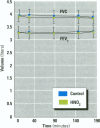Abstract
Nitrous acid, a component of photochemical smog and a common indoor air pollutant, may reach levels of 100 ppb where gas stoves and unvented portable kerosene heaters are used. Nitrous acid is a primary product of combustion and may also be a secondary product by reaction of nitrogen dioxide with water. Because the usual assays for nitrogen dioxide measure several oxides of nitrogen (including nitrous acid) together, previous studies of indoor nitrogen dioxide may have included exposure to and health effects of nitrous acid. To assess the respiratory effects of nitrous acid exposure alone, we carried out a double-blinded crossover chamber exposure study with 11 mildly asthmatic adult subjects. Each underwent 3-hr exposures to 650 ppb nitrous acid and to filtered room air with three 20-min periods of moderate cycle exercise. Symptoms, respiratory parameters during exercise, and spirometry after exercise were measured. A statistically significant decrease in forced vital capacity was seen on days when subjects were exposed to nitrous acid. This effect was most marked at 25 min and 85 min after exposure began. Aggregate respiratory and mucous membrane symptoms were also significantly higher with nitrous acid. We conclude that this concentration and duration of exposure to nitrous acid alters lung mechanics slightly, does not induce significant airflow obstruction, and produces mild irritant symptoms in asthmatics.
Full text
PDF



Images in this article
Selected References
These references are in PubMed. This may not be the complete list of references from this article.
- Aris R., Christian D., Sheppard D., Balmes J. R. Lack of bronchoconstrictor response to sulfuric acid aerosols and fogs. Am Rev Respir Dis. 1991 Apr;143(4 Pt 1):744–750. doi: 10.1164/ajrccm/143.4_Pt_1.744. [DOI] [PubMed] [Google Scholar]
- Avol E. L., Linn W. S., Shamoo D. A., Anderson K. R., Peng R. C., Hackney J. D. Respiratory responses of young asthmatic volunteers in controlled exposures to sulfuric acid aerosol. Am Rev Respir Dis. 1990 Aug;142(2):343–348. doi: 10.1164/ajrccm/142.2.343. [DOI] [PubMed] [Google Scholar]
- Brauer M., Koutrakis P., Keeler G. J., Spengler J. D. Indoor and outdoor concentrations of inorganic acidic aerosols and gases. J Air Waste Manage Assoc. 1991 Feb;41(2):171–181. doi: 10.1080/10473289.1991.10466834. [DOI] [PubMed] [Google Scholar]
- Fine J. M., Gordon T., Thompson J. E., Sheppard D. The role of titratable acidity in acid aerosol-induced bronchoconstriction. Am Rev Respir Dis. 1987 Apr;135(4):826–830. doi: 10.1164/arrd.1987.135.4.826. [DOI] [PubMed] [Google Scholar]
- Goldstein E., Peek N. F., Parks N. J., Hines H. H., Steffey E. P., Tarkington B. Fate and distribution of inhaled nitrogen dioxide in rhesus monkeys. Am Rev Respir Dis. 1977 Mar;115(3):403–412. doi: 10.1164/arrd.1977.115.3.403. [DOI] [PubMed] [Google Scholar]
- Hazucha M. J., Bates D. V., Bromberg P. A. Mechanism of action of ozone on the human lung. J Appl Physiol (1985) 1989 Oct;67(4):1535–1541. doi: 10.1152/jappl.1989.67.4.1535. [DOI] [PubMed] [Google Scholar]
- Health effects of atmospheric acids and their precursors. Report of the ATS workshop on the Health Effects of Atmospheric Acids and their Precursors. Am Rev Respir Dis. 1991 Aug;144(2):464–467. doi: 10.1164/ajrccm/144.2.464. [DOI] [PubMed] [Google Scholar]
- Koenig J. Q., Pierson W. E., Horike M. The effects of inhaled sulfuric acid on pulmonary function in adolescent asthmatics. Am Rev Respir Dis. 1983 Aug;128(2):221–225. doi: 10.1164/arrd.1983.128.2.221. [DOI] [PubMed] [Google Scholar]
- Larson T. V. The influence of chemical and physical forms of ambient air acids on airway doses. Environ Health Perspect. 1989 Feb;79:7–13. doi: 10.1289/ehp.89797. [DOI] [PMC free article] [PubMed] [Google Scholar]
- Morris J. F., Koski A., Johnson L. C. Spirometric standards for healthy nonsmoking adults. Am Rev Respir Dis. 1971 Jan;103(1):57–67. doi: 10.1164/arrd.1971.103.1.57. [DOI] [PubMed] [Google Scholar]
- Pearson S. D., Gan J. C. The inactivation of plasma alpha 1-proteinase inhibitor by nitrous acid. Int J Biochem. 1985;17(11):1253–1262. doi: 10.1016/0020-711x(85)90016-3. [DOI] [PubMed] [Google Scholar]
- Postlethwait E. M., Bidani A. Mechanisms of pulmonary NO2 absorption. Toxicology. 1994 May 20;89(3):217–237. doi: 10.1016/0300-483x(94)90099-x. [DOI] [PubMed] [Google Scholar]
- Pryor W. A., Lightsey J. W. Mechanisms of nitrogen dioxide reactions: initiation of lipid peroxidation and the production of nitrous Acid. Science. 1981 Oct 23;214(4519):435–437. doi: 10.1126/science.214.4519.435. [DOI] [PubMed] [Google Scholar]



